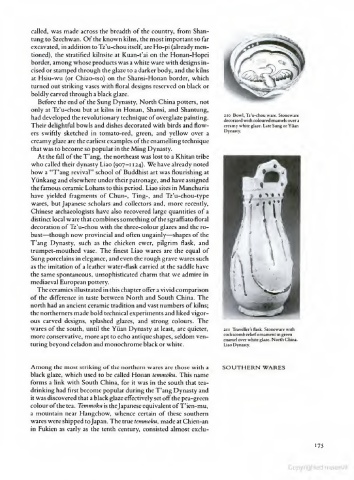Page 195 - The Arts of China, By Michael Sullivan Good Book
P. 195
called, was made across the breadth of the country, from Shan-
tung to Szcchwan. Of the known kilns, the most important so far
excavated, in addition to Tz'u-chou itself, are Ho-pi (already men-
tioned), the stratified kilnsite at Kuan-t'ai on the Honan-Hopei
border, among whose products was a white ware with designs in-
cised or stamped through the glaze to a darker body, and the kilns
at Hsiu-wu (or Chiao-tso) on the Shansi-Honan border, which
turned out striking vases with floral designs reserved on black or
boldly carved through a black glaze.
Before the end of the Sung Dynasty, North China potters, not
only at Tz'u-chou but at kilns in Honan, Shansi, and Shantung,
210 Bowl, Tz'u-chou wire. Stoneware
had developed the revolutionary technique of overglaze painting.
decorated with coloured enamels over a
Their delightful bowls and dishes decorated with birds and flow- creamy white glare Late Sung or Yuan
Dynasty.
ers swiftly sketched in tomato-red, green, and yellow over a
creamy glaze are the earliest examples of the enamelling technique
that was to become so popular in the Ming Dynasty.
At the fall of the T'ang, the northeast was lost to a Khitan tribe
who called their dynasty Liao (907-1 124). We have already noted
how a "T'ang revival" school of Buddhist art was flourishing at
Yiinkang and elsewhere under their patronage, and have assigned
the famous ceramic Lohans to this period. Liao sites in Manchuria
have yielded fragments of Chun-, Ting-, and Tz'u-chou-typc
wares, but Japanese scholars and collectors and, more recently,
Chinese archaeologists have also recovered large quantities of a
distinct local ware that combines something of the sgraffiato floral
decoration of Tz'u-chou with the three-colour glazes and the ro-
bust—though now provincial and often ungainly—shapes of the
T'ang Dynasty, such as the chicken ewer, pilgrim flask, and
trumpet-mouthed vase. The finest Liao wares are the equal of
Sung porcelains in elegance, and even the rough grave wares such
as the imitation of a leather water-flask carried at the saddle have
the same spontaneous, unsophisticated charm that we admire in
mediaeval European pottery.
The ceramics illustrated in this chapter offer a vivid comparison
of the difference in taste between North and South China. The
north had an ancient ceramic tradition and vast numbers of kilns;
the northerners made bold technical experiments and liked vigor-
ous carved designs, splashed glazes, and strong colours. The
wares of the south, until the Yiian Dynasty at least, are quieter, 21 1 Traveller's flask. Stoneware with
more conservative, more apt to echo antique shapes, seldom ven- cockscomb relief ornament in green
enamel over white glaze. North China.
turing beyond celadon and monochrome black or white. Liao Dynasty.
Among the most striking of the northern wares are those with a SOUTHERN WARES
black glaze, which used to be called Honan temmoku. This name
forms a link with South China, for it was in the south that tea-
drinking had first become popular during the T'ang Dynasty and
it was discovered that a black glaze effectively set off" the pea-green
colour of the tea. Temmoku is thejapanese equivalent of T'ien-mu,
a mountain near Hangchow, whence certain of these southern
wares were shipped tojapan. The true temmoku, made at Chien-an
in Fukien as early as the tenth century, consisted almost exclu-

